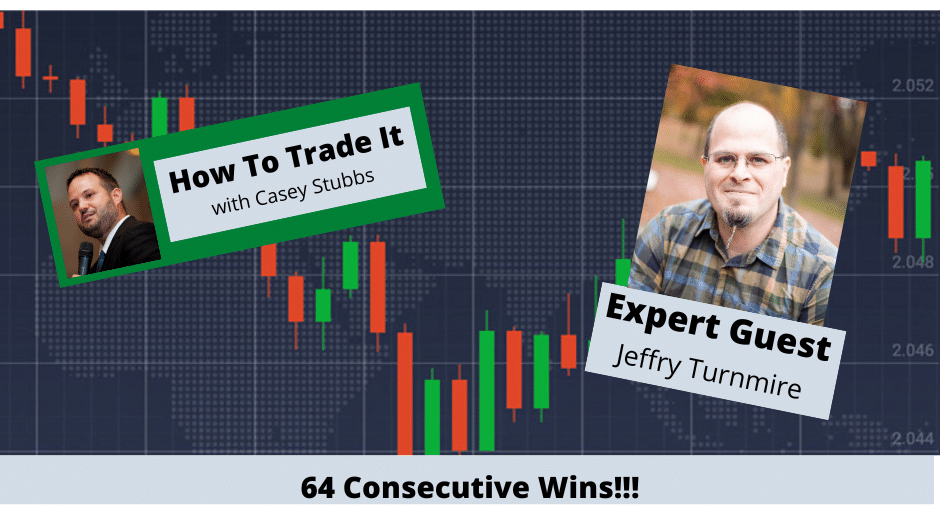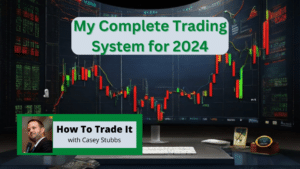64 Consecutive Wins: Jeffry Turnmire Unveils His Winning Strategy

Jeffry Turnmire is not your typical “expert.” He didn’t get his training on Wall Street, and he’s never managed a hedge fund. He’s a normal guy from Knoxville, TN — a professional engineer and urban farmer (among many other hobbies). Jeffry has spent over two decades honing his real money trading skills, ever since he started paper trading in elementary school (we’re serious). He opened a real-money account as soon as he could and has been learning and growing as a trader ever since. You don’t want to miss this episode!
Jeffry specializes in identifying straightforward techniques and building strategies no one else has discovered yet. His trademark system, Echo Trades, helped him grow his family’s accounts to $1.4 million during the crash of 2020, and also caught the eye of famous traders, who asked him to bring his system to the public. Since then, he’s been helping thousands of traders learn his direct, no-nonsense approach to trading, wisdom that he picked up on Main Street, not Wall Street.
Subscribe to How To Trade It
Show highlights include…
Urban Farming and Trading
-
-
- Jeffry talks about his unique experience as an urban farmer, getting approval to run a farm in a residential area.
- Casey and Jeffry draw parallels between farming and trading, emphasizing the need for planning, aggressiveness, and tracking financials in both pursuits.
-
Profitability in Farming and Trading
-
-
- Jeffry and Casey discuss the importance of tracking costs and revenues in farming and trading to determine profitability.
- Casey highlights the importance of knowing your break-even point in options trading.
-
The Impact of Options
-
-
- Jeffry shares his early trading experiences, including learning about options and experiencing the dot-com bust.
- Casey discusses the intricacies of options trading, such as break-even points and understanding extrinsic and intrinsic values.
-
The Value of Seat Time
-
-
- Jeffry emphasizes the importance of spending time studying charts and learning from experienced traders.
- He shares his journey of learning Elliott Wave Theory and using it in his trading.
-
Algorithmic Trading
-
-
- Jeffry talks about his experience building trading algorithms, highlighting the need for flexibility in algorithms to adapt to changing market conditions.
- He discusses his success in identifying wave 3 patterns and how he integrated them into his EchoTrade system.
-
Jeffry Turnmire’s Transition into Trading
-
-
- Jeffry started his trading journey while working in construction.
- He joined a coaching group led by Rob Booker, where he learned about rules-based trading.
- Rob Booker recognized Jeffry’s potential and invited him to teach options trading to his coaching group.
- Jeffry emphasizes the importance of being able to relate to regular people, which set him apart from many traditional traders.
- He shares how he quickly gained a large following and his mission to help regular people learn to trade without falling for scams.
-
Favorite Trade Setup
-
-
- Jeffry’s go-to trade setup is a measured bounce setup, which is based on Elliott Wave Theory.
- He aims to risk 1% of his capital to potentially make 3 to 10 times his investment.
- Jeffry explains that he focuses on the first move up in the wave three, which is typically 1.618 times bigger than the wave one.
- He talks about the Fibonacci extension levels and how he tries to catch specific patterns in the market.
-
Unconventional Strategy
-
-
- Jeffry discusses a unique trading strategy that has led to 64 consecutive winning trades.
- He describes how this strategy exploits a premium anomaly in certain index options, such as SPX and XSP.
- Jeffry highlights the benefits of trading index options, which cannot be exercised early and offer specific tax advantages.
- He explains the nuances of this strategy and how it’s based on detailed analysis and specific timing.
- The strategy involves selling premium when certain anomalies occur in the options market.
-
Frequency of Trading
-
-
- Jeffry has been running this trading strategy for over 19 months and has achieved 64 consecutive wins.
- He typically trades one or two times a week, but the opportunities come in clusters.
- Jeffry emphasizes the importance of patience in trading and waiting for the right setups.
- He discusses the impact of market conditions and implied volatility on the strategy’s effectiveness.
- Casey mentions the importance of patience, discipline, and not forcing trades.
-
Trading and Learning
-
-
- Jeffry believes that the trading anomaly he exploits is ingrained in pricing algorithms and is unlikely to disappear.
- He has a disciplined approach to trading, combining technical analysis and risk management.
- Casey and Jeffry emphasize the significance of good habits, discipline, and constant learning in trading.
-
Jeffry Turnmire in Action
-
-
- Jeffry runs a YouTube channel called “Jeffry Turnmire Trading“
- He goes live each morning before the US markets open to discuss market news, movers, and opportunities.
- Jeffry provides insights and sets the direction for the day.
- He hosts a special show on Tuesday afternoons called “30MA – 30 Minutes of Awesome,” where he analyzes tickers based on requests from viewers.
- Jeffry offers viewers an opportunity to join his Discord server for further interaction and learning.
- Jeffry runs a YouTube channel called “Jeffry Turnmire Trading“
-
Subscribe to How To Trade It
The 2020 Market Crash
1. The Onset of the Crisis: The early signs of the market crash were noticeable in late February 2020 when major stock indices worldwide started experiencing a sharp decline in value. Initially, it was largely driven by concerns related to the impact of the pandemic on global supply chains, travel, and trade.
2. Rapid Spread of the Virus: As the COVID-19 virus spread to different countries, governments implemented lockdowns and quarantine measures to control the outbreak. This led to an abrupt and severe disruption in business operations and consumer behavior.
3. Widespread Panic: Investor sentiment quickly shifted from optimism to fear, as it became evident that the pandemic would lead to a global economic slowdown. Investors began selling off stocks, bonds, and other assets, causing massive drops in equity markets.
4. Record Stock Market Declines: In March 2020, major stock market indices worldwide experienced record-breaking declines. The Dow Jones Industrial Average (DJIA) and the S&P 500 in the United States, as well as indices in Europe and Asia, recorded significant losses.
5. Oil Price War: Concurrently, there was an oil price war between Russia and Saudi Arabia, which exacerbated the market crash. Oil prices plummeted as demand for oil fell significantly due to the pandemic’s effect on global travel and manufacturing.
6. Government Responses: In an attempt to counteract the economic impact of the crisis, governments worldwide initiated unprecedented stimulus measures. Central banks reduced interest rates, and governments introduced fiscal policies aimed at supporting businesses, workers, and healthcare systems.
7. High Volatility: The market displayed extreme volatility during this period, with some days seeing large gains followed by substantial losses, making it a challenging environment for both professional and retail investors.
8. Recovery and New Investment Trends: As the pandemic continued, some sectors like technology and e-commerce experienced growth, reflecting changing consumer behavior. Cryptocurrencies also gained attention as alternative assets. Investors began to search for safe havens and diversification opportunities.
9. The Role of Technology: The use of technology became even more crucial during the pandemic. Remote work, e-learning, and e-commerce saw significant expansion, leading to increased investments in tech-related companies.
10. Long-Term Implications: The 2020 market crash had far-reaching implications for economies, businesses, and individuals. It accelerated trends like digitalization, remote work, and e-commerce. It also heightened discussions about income inequality, healthcare systems, and the importance of financial resilience.
11. Stock Market Recovery: Over time, markets gradually recovered. Government interventions, optimism about vaccine development, and adaptation to the new normal contributed to the rebound in asset prices.
The 2020 market crash serves as a reminder of the interconnectedness of financial markets, economies, and global events. It highlighted the importance of risk management, diversification, and having a long-term investment strategy. The lessons learned from this crisis continue to influence economic and investment decisions around the world.
Connect with Jeffry Turnmire
- YouTube: https://www.youtube.com/channel/UCReO37LaMZHH0VvEDOGLR7w
- Website: https://jeffrytrader.com/
- Twitter: http://x.com/JeffryTurnmire
Connect With Casey Stubbs
- Website: https://tradingstrategyguides.com/
- Website: https://caseystubbs.com
- Website: https://globalproptrader.com/
- YouTube: https://www.youtube.com/TradingStrategyGuides
- YouTube: https://www.youtube.com/caseystubbs
- Twitter: https://www.twitter.com/caseystubbs
- Facebook: https://www.facebook.com/TradingStrategyGuides
- LinkedIn: https://www.linkedin.com/in/caseystubbs/






